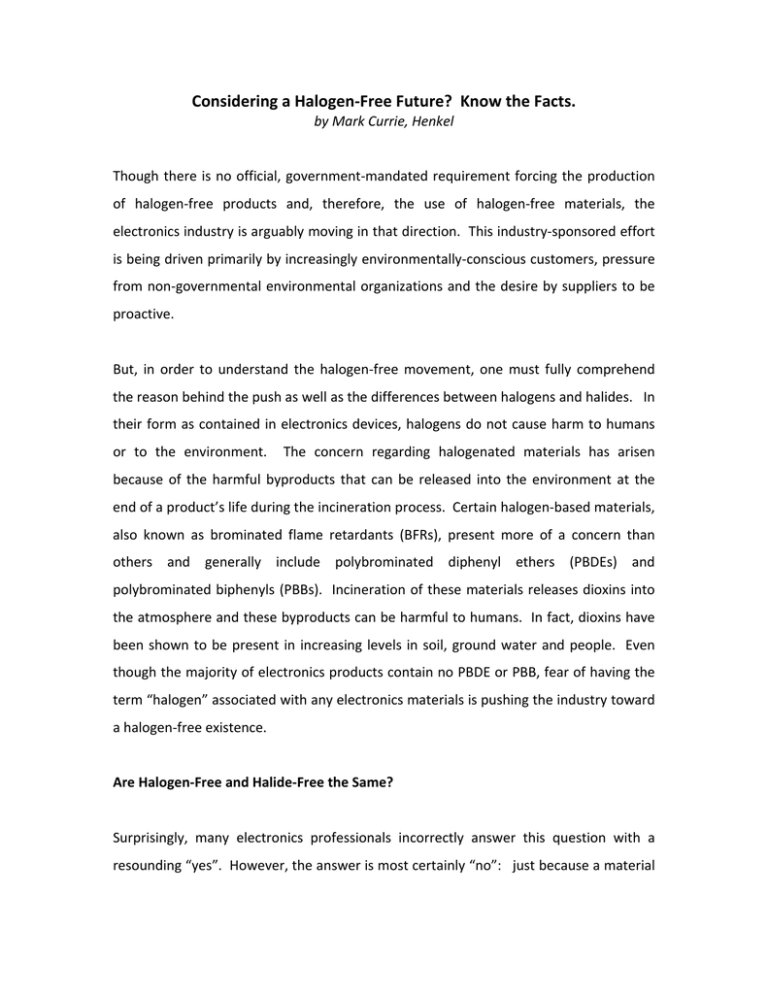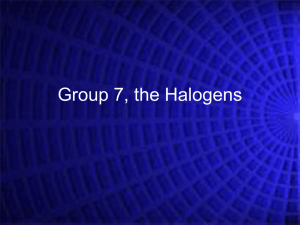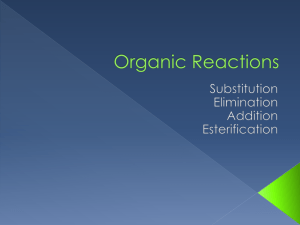Considering a Halogen-Free Future? Know the Facts.
advertisement

Considering a Halogen‐Free Future? Know the Facts. by Mark Currie, Henkel Though there is no official, government‐mandated requirement forcing the production of halogen‐free products and, therefore, the use of halogen‐free materials, the electronics industry is arguably moving in that direction. This industry‐sponsored effort is being driven primarily by increasingly environmentally‐conscious customers, pressure from non‐governmental environmental organizations and the desire by suppliers to be proactive. But, in order to understand the halogen‐free movement, one must fully comprehend the reason behind the push as well as the differences between halogens and halides. In their form as contained in electronics devices, halogens do not cause harm to humans or to the environment. The concern regarding halogenated materials has arisen because of the harmful byproducts that can be released into the environment at the end of a product’s life during the incineration process. Certain halogen‐based materials, also known as brominated flame retardants (BFRs), present more of a concern than others and generally include polybrominated diphenyl ethers (PBDEs) and polybrominated biphenyls (PBBs). Incineration of these materials releases dioxins into the atmosphere and these byproducts can be harmful to humans. In fact, dioxins have been shown to be present in increasing levels in soil, ground water and people. Even though the majority of electronics products contain no PBDE or PBB, fear of having the term “halogen” associated with any electronics materials is pushing the industry toward a halogen‐free existence. Are Halogen‐Free and Halide‐Free the Same? Surprisingly, many electronics professionals incorrectly answer this question with a resounding “yes”. However, the answer is most certainly “no”: just because a material is halide‐free doesn’t mean it is also halogen‐free. The bullets below help explain the differences. Halides Ionic and have a charge (example Cl‐, Br‐ , and F‐) Added to solder paste to improve activity, encourage cleaning Generally hydroscopic and can cause stability challenges No clean fluxes normally encapsulate remaining halide constituents post reflow in the rosin to ensure post assembly reliability Halogens Covalently bonded group VIIA element without a net ionic charge (example Cl2, Br2, and F2); not available for fluxing activity at room temperature but only at high temperature Primary source in electronics assemblies is in BFRs in laminates Certain halogens – PBBs and PBDEs – present potential toxicity problems when incinerated (causing dioxins) Used in solder paste to enhance activity without impact to reliability Further, it is important to understand the different reactions of halides and halogen materials both at room temperature and at elevated temperatures. Ionic halide bonds are typically easily broken, which allows free halide to react with moisture and cause corrosion at room temperatures. Conversely, covalently bonded halides are much more stable at room temperature and the bonds are not easily broken. At elevated temperatures – such as those consistent with soldering – the covalent bonds are broken and the halide can react with the oxide to clean and encourage wetting. Likewise, the test requirements for halide‐free and halogen‐free materials are completely different. While international standards have been set for halide‐free, high reliability solder interconnects and the test procedures have been well‐established, the same cannot be said for halogen‐free. Figure 1 below further illustrates these differences. Figure 1: Classifications, test procedures and standards for halide‐free and halogen‐free. As one can see from this chart, these standards – particularly the three main standards that relate to halogen‐free – do not mean 0 ppm halogen. So, the majority of today’s so‐called “halogen‐free” materials are, if they are just below the limit as set by these standards, really “halogen‐light”. The other huge hurdle in relation to halogen‐free materials is the testing regimen. As halogens have a neutral charge and cannot be detected by standard ion chromatography, they must be converted into ionic halides through a combustion process. What this means is that many so‐called halide‐free materials may, in fact, contain hidden halides. Under the current analytical methods, testing occurs during a state in which chemical bonds are not broken, but are kept under isolation in a neutral charge format. When these chemicals are heated up – like what happens during the solder reflow process ‐ ‐the bonds are broken and the halides can then be detected. So, many products that claim to be “halide‐free” might be so at room temperature but, once changed during the manufacturing process, can contain halogens far outside of the current recommended ppm limits. Is it Really Halogen‐Free? To be sure, removing the halogen from a material isn’t difficult; the challenge lies in how it is replaced. Covalently bonded halogen delivers tremendous benefits for the soldering process including printer open time, thermal stability, the reflow process window and the shelf‐life. Because of these facts, many in the industry use small amounts of halogen that fall just below the currently defined ppm limits. Though valid from a formulation point of view, the danger is that excess halogenated materials can be added during the manufacturing process. (See Figures 2a and 2b Energy‐dispersive X‐ray Spectroscopy images.) Figure 2a: EDX analysis detects flux residues on reflowed solder. Results here show no halogen detected. Tin, silver and copper are detected. Figure 2b: EDX analysis of flux residues on reflowed solder. Results show a halogen containing flux system, detection of Chlorine. Analysis at the base of the solder joint also note silicon and copper presence (origin is the printed circuit board). The only way to ensure a truly halogen‐free product is to have zero deliberately added halogens in the formulation and products constructed of the purest raw materials available. Even the lack of deliberate additions of halogen can result in halogen‐ containing products, as many of the raw materials can contain impurities. It is critical, therefore, to partner with a supplier that has access to raw materials with the least amount of impurities and materials scientists with the expertise to design a solder system that maintains all of the performance characteristics consistent with modern solder materials but without the halgoen. This is a difficult task, indeed, and its safe to say that only a very few suppliers have these resources and are also not deliberately adding halogens to their materials. It is imperative to go to these lengths, though, because of the risk of halogenated materials being added during the manufacturing process. The situation is complicated even further due to the testing challenges halogen‐free introduces, with manufacturers largely relying on their suppliers to confirm the purity of the materials they are receiving. Now more than ever, partnering with a supplier that has the resource, expertise and formulation know‐how to develop truly halogen‐free products is crucial. Though there are still many question marks in relation to halogen‐free manufacturing, understanding these important halide‐free and halogen‐free distinctions, as well as the current halogen‐free requirements, will help ensure a truly halogen free production process. Armed with these facts, should government mandates become a reality, those in the know will be far more prepared to comply.

